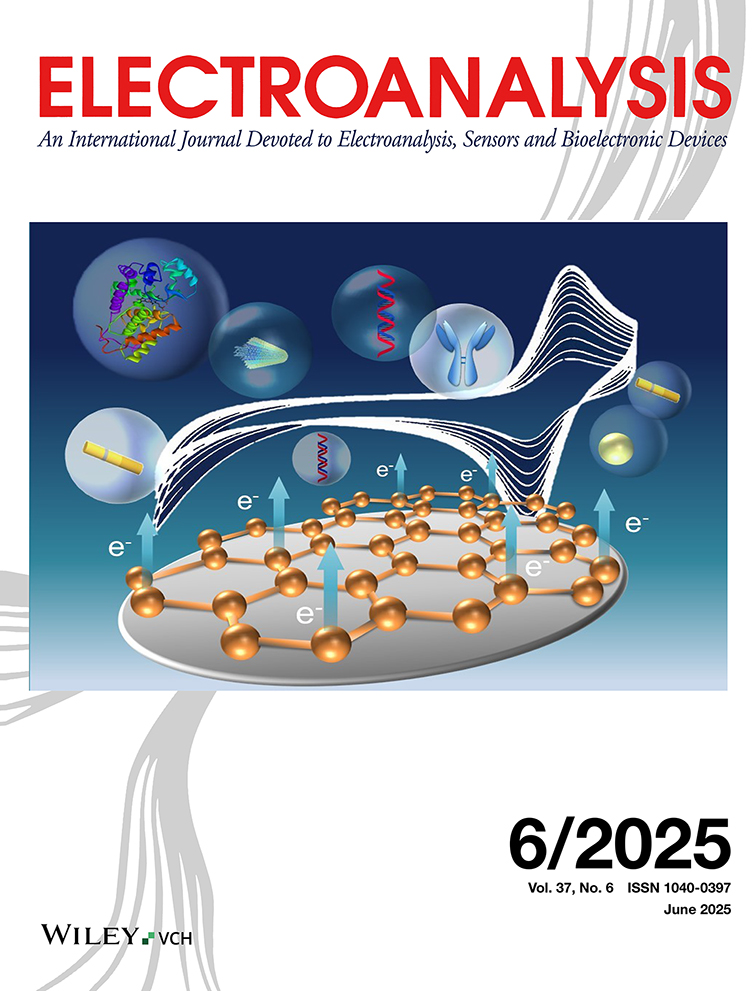Electrochemical Biosensing Platforms Using Phthalocyanine-Functionalized Carbon Nanotube Electrode
Jian-Shan Ye
Department of Biological Sciences, National University of Singapore, 14 Science Drive 4, Singapore 117543
Search for more papers by this authorYing Wen
Department of Chemistry, National University of Singapore, 14 Science Drive 4, Singapore 117543
Search for more papers by this authorWei De Zhang
Institute of Materials Research and Engineering, 3 Research Link, Singapore 117602
Search for more papers by this authorHui Fang Cui
Department of Biological Sciences, National University of Singapore, 14 Science Drive 4, Singapore 117543
Search for more papers by this authorGuo Qin Xu
Department of Chemistry, National University of Singapore, 14 Science Drive 4, Singapore 117543
Search for more papers by this authorFwu-Shan Sheu
Department of Biological Sciences, National University of Singapore, 14 Science Drive 4, Singapore 117543
The University Scholars Programme, National University of Singapore, 10 Kent Ridge Crescent, Singapore 119260
Search for more papers by this authorJian-Shan Ye
Department of Biological Sciences, National University of Singapore, 14 Science Drive 4, Singapore 117543
Search for more papers by this authorYing Wen
Department of Chemistry, National University of Singapore, 14 Science Drive 4, Singapore 117543
Search for more papers by this authorWei De Zhang
Institute of Materials Research and Engineering, 3 Research Link, Singapore 117602
Search for more papers by this authorHui Fang Cui
Department of Biological Sciences, National University of Singapore, 14 Science Drive 4, Singapore 117543
Search for more papers by this authorGuo Qin Xu
Department of Chemistry, National University of Singapore, 14 Science Drive 4, Singapore 117543
Search for more papers by this authorFwu-Shan Sheu
Department of Biological Sciences, National University of Singapore, 14 Science Drive 4, Singapore 117543
The University Scholars Programme, National University of Singapore, 10 Kent Ridge Crescent, Singapore 119260
Search for more papers by this authorAbstract
Iron-phthalocyanines (FePc) are functionalized at multi-walled carbon nanotubes (MWNTs) to remarkably improve the sensitivity toward hydrogen peroxide. We constructed a highly sensitive and selective glucose sensor on FePc-MWNTs electrode based on the immobilization of glucose oxidase (GOD) on poly-o-aminophenol (POAP)-electropolymerized electrode surface. SEM images indicate that GOD enzymes trapped in POAP film tend to deposit primarily on the curved tips and evenly disperse along the sidewalls. The resulting GOD@POAP/FePc-MWNTs biosensor exhibits excellent performance for glucose with a rapid response (less than 8 s), a wide linear range (up to 4.0×10−3 M), low detection limits (2.0×10−7 M with a signal-to-noise of 3), a highly reproducible response (RSD of 2.6%), and long-term stability (120 days). Such characteristics may be attributed to the catalytic activity of FePc and carbon nanotube, permselectivity of POAP film, as well as the large surface area of carbon nanotube materials.
References
- 1 S. Iijima, Nature 1991, 354, 56.
- 2 H. X. Luo, Z. J. Shi, N. Q. Li, Z. N. Gu, Q. K. Zhuang, Anal. Chem. 2001, 73, 915.
- 3 J. Li, A. Cassell, L. Delzeit, J. Han, M. Meyyappan, J. Phys. Chem. B 2002, 106, 9299.
- 4 J. M. Nugent, K. S. V. Santhanam, A. Rubio, P. M. Ajayan, Nano Lett. 2001, 1, 87.
- 5 B. R. Azamian, J. J. Davis, K. S. Coleman, C. B. Bagshaw, M. L. H. Green, J. Am. Chem. Soc. 2002, 124, 12664.
- 6 S. Hrapovic, Y. L. Liu, K. B. Male, J. H. T. Luong, Anal. Chem. 2004, 76, 1083
- 7 J. Z. Xu, J. J. Zhu, Q. Wu, Z. Hu, H. Y. Chen, Electroanalysis 2003, 15, 219.
- 8 W. D. Zhang, Y. Wen, S. M. Lin, W. C. Tjiu, G. Q. Xu, L. M. Gan, Carbon 2002, 40, 1981.
- 9 W. D. Zhang, Y. Wen, W. C. Tjiu, G. Q. Xu, L. M. Gan, Appl. Phys. A 2002, 74, 419.
- 10 W. D. Zhang, Y. Wen, J. Li, G. Q. Xu, L. M. Gan, Thin Solid Films 2002, 422, 120.
- 11 J. S. Ye, Y. Wen, W. D. Zhang, L. M. Gan, G. Q. Xu, F. S. Sheu, Electroanalysis 2003, 15, 1693.
- 12 T. Taksuma, M. Gordaira, T. Watanabe, Anal. Chem. 1992, 64, 1183.
- 13 N. C. Foulds, C. R. Lowe, Anal. Chem. 1988, 60, 2473.
- 14 S. Lu, C. Li, D. Zhang, Y. Zhang, Z. Mo, Q. Cai, A. Zhu, J. Electroanal. Chem. Interfacial Electrochem. 1994, 364, 31.
- 15 J. J. Xu, H. Y. Chen, Anal Chim. Acta 2000, 423, 101.
- 16 J. J. Xu, H. Y. Chen, Anal. Biochem. 2000, 280, 221.
- 17 Z. E. Zhang, H. Y. Liu, J. Q. Deng, Anal. Chem. 1996, 68, 1632.
- 18 M. D. Santamaria, M. D. V. Barbado, M. L. T. Garcia, P. S. Batanero, Quim. Anal. 1998, 17, 147.
- 19 A. A. Ciucu, C. Negulescu, R. P. Baldwin, Biosens. Bioelectron. 2003, 18, 303.
- 20 C. A. Caro, J. H. Zagal, F. Bedioui, J. Electrochem. Soc. 2003, 150, E95.
- 21 B. Ballarin, M. Gazzano, J. L. H. H. de Cisneros, D. Tonelli, R. Seeber, Anal. Bioanal. Chem. 2002, 374, 891.
- 22 N. Pereira-Rodrigues, V. Albin, M. Koudelka-Hep, V. Auger, A. Pailleret, F. Bedioui, Electrochem. Commun. 2002, 4, 922.
- 23 J. Oni, P. Westbroek, T. Nyokong, Electroanalysis 2002, 14, 1165.
- 24 B. X. Wang, Y. Q. Liu, W. F. Qiu, D. B. Zhu, J. Mater. Chem. 2002, 12, 1636.
- 25 L. Cao, H. Z. Chen, H. B. Zhou, L. Zhu, J. Z. Sun, X. B. Zhang, J. M. Xu, M. Wang, Adv. Mater. 2003, 15, 909.
- 26 H. F. Hsu, S. R. Wilson, J. R. Shapley, Chem. Commun. 1997, 1125.
- 27 Y. D. Zhao, W. D. Zhang, H. Chen, Q. M. Luo, Anal. Sci. 2002, 18, 939.
- 28 J. Wang, Anal. Chem. 1995, 67, 487R.
- 29 M. J. Stillman, T. Nyokong, Phthalocyanines, Properties and Applications, Vol. 3, VCH, New York 1993, , p. 133.
- 30 C. C. Leznoff, A. B. P. Lever, Phthalocyanines, Properties and Applications; VCH Publishers: New York 1989; Vol. 1.
- 31 A. J. Bard, L. R. Faulkner, Electrochemical Methods (2nd ed.), Wiley, New York 2001.
- 32 Q. J. Chi, S. J. Dong, Anal. Chim. Acta 1993, 278, 17.
- 33 J. Wang, M. Musameh, Y. H. Lin, J. Am. Chem. Soc. 2003, 125, 2408.
- 34 J. Wang, M. Musameh, Anal. Chem. 2003, 75, 2075.
- 35 S. G. Wang, Q. Zhang, R. Wang, S. F. Yoon, J. Ahn, D. J. Yang, J. Z. Tian, J. Q. Li, Q. Zhou, Electrochem. Commun. 2003, 5, 800.
- 36 A. Guiseppi-Elie, C. Lei, R. H. Baughman, Nanotechnology 2002, 13, 559.
- 37 A. Szucs, G. D. Hitchens, J. O. Bockris, J. Electrochem. Soc. 1989, 136, 3748.
- 38 Q. Chi, J. Zhang, S. Dong, E. Wang, Electrochim. Acta 1994, 39, 2431.
- 39 C. Barbero, J. J. Silber, L. Sereno, J. Electroanal. Chem. Interfacial Electrochem. 1989, 263, 333.
- 40 A. Q. Zhang, C. Q. Cui, Y. Z. Chen, J. Y. Lee, J. Electroanal. Chem. Intefacial Electrochem. 1994, 373, 115.
- 41 S. Kunimura, T. Ohsaka, N. Oyama, Macromolecules 1998, 21, 894.
- 42 T. Ohsaka, S. Kunimura, N. Oyama, Electrochim. Acta 1988, 33, 639.
- 43 M. L. Fung, J. S. Ye, P. C. W. Fung, Pflug. Arch. Eur. J. Physiol. 2001, 442, 903.
- 44 J. S. Ye, G. L. Tipoe, P. C. W. Fung, M. L. Fung, Pflug. Arch. Eur. J. Physiol. 2002, 444, 178.
- 45 S. M. Golabi, A. Nozad, Electroanalysis 2003, 15, 278.
- 46 C. Malitesta, F. Palmisano, L. Torsi, P. G. Zambonin, Anal. Chem. 1990, 62, 2735.
- 47 S. M. Golabi, A. Nozad, Electroanalysis 2003, 15, 278.
- 48 C. Downs, J. Nugent, P. M. Ajayan, Adv. Mater. 1999, 11, 1028.
- 49 J. H. Chen, Z. P. Huang, D. Z. Wang, S. X. Yang, W. Z. Li, J. G. Wen, Z. F. Ren, Synth. Metals 2002, 125, 289.
- 50 M. C. Rodriguez, G. A. Rivas, Electroanalysis 1999, 11, 558.





